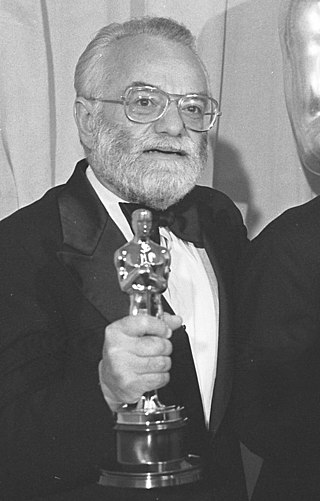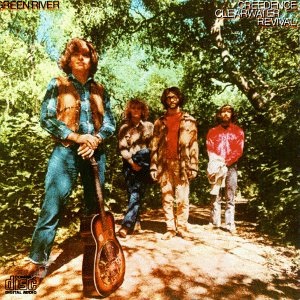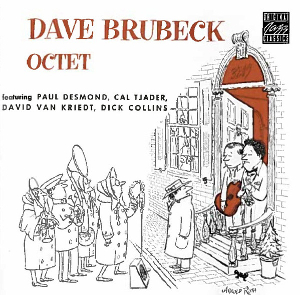
David Warren Brubeck was an American jazz pianist and composer. Often regarded as a foremost exponent of cool jazz, Brubeck's work is characterized by unusual time signatures and superimposing contrasting rhythms, meters, and tonalities.

Vincent Anthony Guaraldi was an American jazz pianist best known for composing music for animated television adaptations of the Peanuts comic strip. His compositions for this series included their signature melody "Linus and Lucy" and the holiday standard "Christmas Time Is Here". He is also known for his performances on piano as a member of Cal Tjader's 1950s ensembles and for his own solo career. His 1962 composition "Cast Your Fate to the Wind" became a radio hit and won a Grammy Award in 1963 for Best Original Jazz Composition. He died of a sudden heart attack on February 6, 1976, at age 47, moments after concluding a nightclub performance in Menlo Park, California.

Creedence Clearwater Revival, commonly abbreviated as CCR or simply Creedence, was an American rock band formed in El Cerrito, California. The band consisted of lead vocalist, lead guitarist, and primary songwriter John Fogerty, his brother, rhythm guitarist Tom Fogerty, bassist Stu Cook, and drummer Doug Clifford. These members had played together since 1959, first as the Blue Velvets and later as the Golliwogs, before settling on Creedence Clearwater Revival in 1967. The band's most prolific and successful period between 1969 and 1971 produced fourteen consecutive Top 10 singles and five consecutive Top 10 albums in the United States – two of which, Green River (1969) and Cosmo's Factory (1970), reached number one. The band performed at the 1969 Woodstock festival in Upstate New York, and was the first major act signed to appear there.

John Cameron Fogerty is an American singer, songwriter and guitarist. Together with Doug Clifford, Stu Cook, and his brother Tom Fogerty, he founded the band Creedence Clearwater Revival (CCR), for which he was the lead singer, lead guitarist, and principal songwriter. CCR had nine top-10 singles and eight gold albums between 1968 and 1972, and was inducted into the Rock and Roll Hall of Fame in 1993.

Callen Radcliffe Tjader Jr. was an American Latin Jazz musician, often described as the most successful non-Latino Latin musician. He explored other jazz idioms, especially small group modern jazz, even as he continued to perform music of Africa, the Caribbean and Latin America.

Wally Heider Studios was a recording studio founded in San Francisco in 1969 by recording engineer and studio owner Wally Heider. Between 1969 and 1980, numerous notable artists recorded at the studios, including Creedence Clearwater Revival, Jefferson Airplane, Crosby, Stills, Nash & Young, and The Grateful Dead. The studio changed ownership in 1980 and was renamed Hyde Street Studios, which is still in operation today.

Saul Zaentz was an American film producer and record company executive. He won the Academy Award for Best Picture three times and, in 1996, was awarded the Irving G. Thalberg Memorial Award.

Creedence Clearwater Revival is the debut studio album by American rock band Creedence Clearwater Revival, released in July 1968, by Fantasy Records in the US. Featuring the band's first hit single, "Susie Q", which reached number 11 in the US charts, it was recorded shortly after the band changed its name from the Golliwogs and began developing a signature swamp rock sound.

Green River is the third studio album by American rock band Creedence Clearwater Revival, released on August 7, 1969 by Fantasy Records. It was the second of three albums they released in that year, preceded by Bayou Country in January and followed by Willy and the Poor Boys in November.

The Long Road Home: The Ultimate John Fogerty/Creedence Collection is a compilation album by American roots rock singer-songwriter John Fogerty, released on November 1, 2005, by Fantasy Records. It compiles songs from Fogerty's solo career and his band Creedence Clearwater Revival. The title refers to Fogerty's return to Fantasy Records, after a lengthy stint with Warner Bros. Records and a brief stint with DreamWorks Records.

The Concert is the second live album by American rock band Creedence Clearwater Revival, released by Fantasy Records in October 1980. It was recorded at the Oakland–Alameda County Coliseum Arena in Oakland, California, on January 31, 1970.

"Run Through the Jungle" is a 1970 song by American rock band Creedence Clearwater Revival. It was released as a double A-side single with "Up Around The Bend" and on the album Cosmo's Factory.

Jazz Impressions of Black Orpheus is the third album by American jazz pianist Vince Guaraldi, released in 1962 on Fantasy Records. It is considered Guaraldi's breakthrough album.

Fantasy Studios was a music recording studio in Berkeley, California, at the Zaentz Media Center, known for its recording of award-winning albums including Journey's Escape and Green Day's Dookie. Built as a private recording studio for artists on the Fantasy Records label in 1971, it was opened to the public in 1980 for recording, mixing and mastering. It was permanently closed on September 15, 2018.

The Dave Brubeck Octet is a jazz album released by The Dave Brubeck Octet in 1956. It compiles the octet's complete recorded output made between 1946 and 1950, which was originally released in other forms. The artwork was credited to Arnold Roth.

Edward Lozano Duran was an American jazz guitarist from San Francisco. He recorded often with Vince Guaraldi and was a member of the Benny Goodman orchestra during the 1970s.

Craft Recordings is a record label owned by Concord. Like UMe, Legacy Recordings and Rhino Entertainment, Craft specialized in reissues of Concord's back catalog. The imprint was founded in 2017, along with an online store by the same name offering a curated selection of deluxe CD and vinyl box sets, stand-alone LPs, and legacy label and artist merchandise. Its first release was a deluxe vinyl edition of Thelonious Monk and John Coltrane’s Complete 1957 Recordings. Sig Sigworth is the president of Craft Recordings.

At Grace Cathedral is a live performance album by jazz pianist Vince Guaraldi, released in the U.S. in September 1965 on Fantasy Records.

The Definitive Vince Guaraldi is Fantasy/Concord Records compilation album of songs by American jazz pianist/composer Vince Guaraldi released on November 3, 2009. It contains 31 tracks over two CDs, highlighting Guaraldi's Peanuts work as well his collaborations with guitarist Bola Sete.

Essential Standards is the third compilation album of songs by American jazz pianist/composer Vince Guaraldi released on June 30, 2009, in the U.S by Concord as part of their Original Jazz Classics series.






















